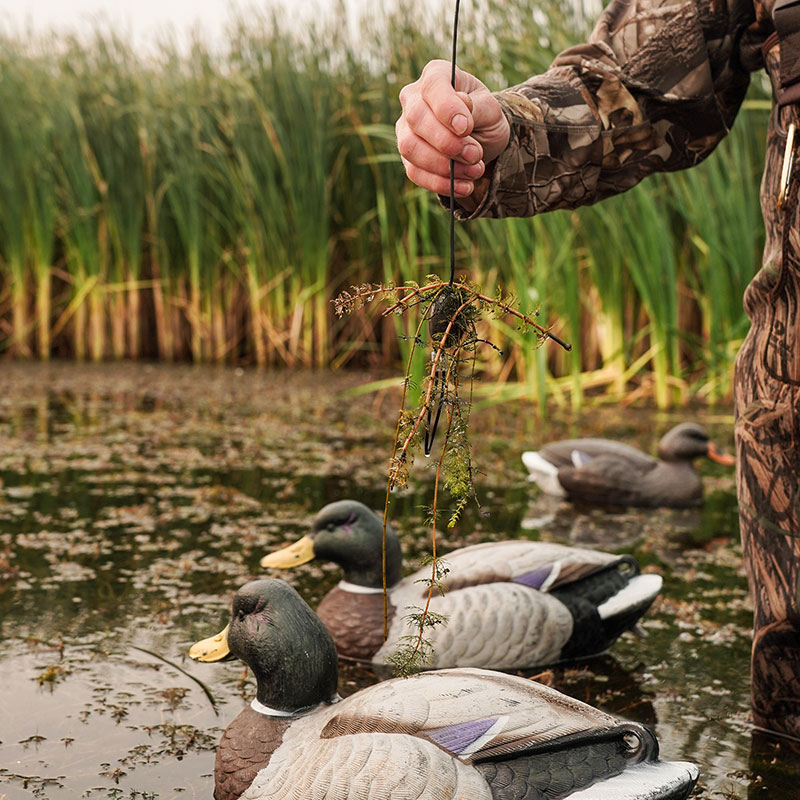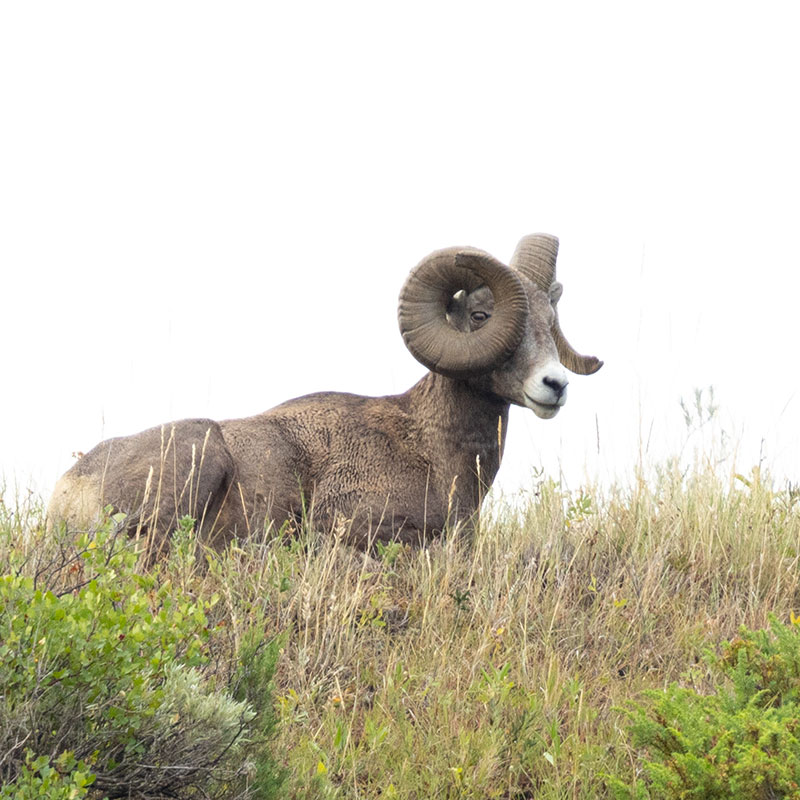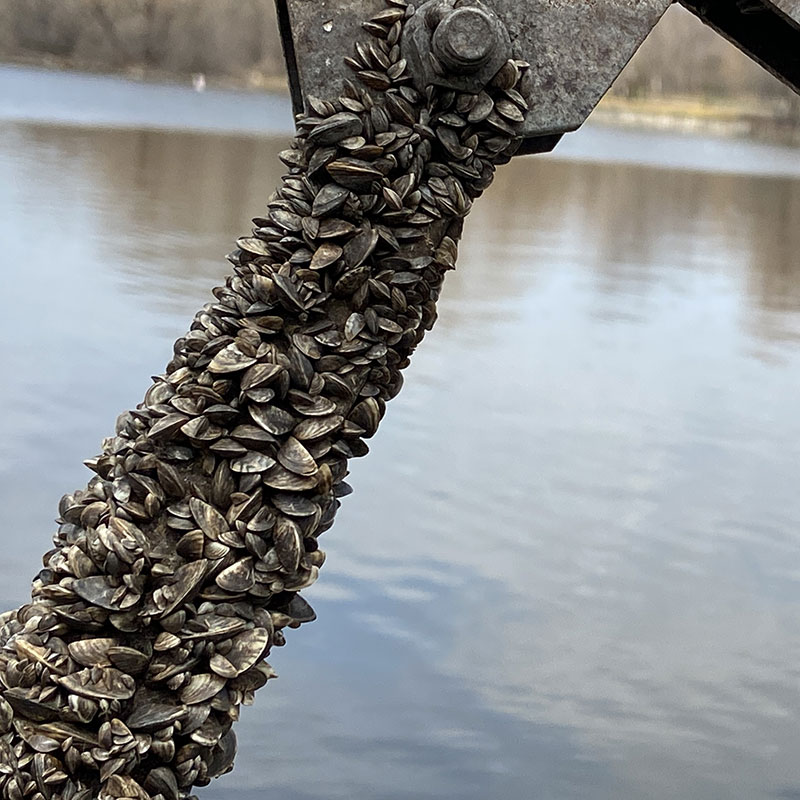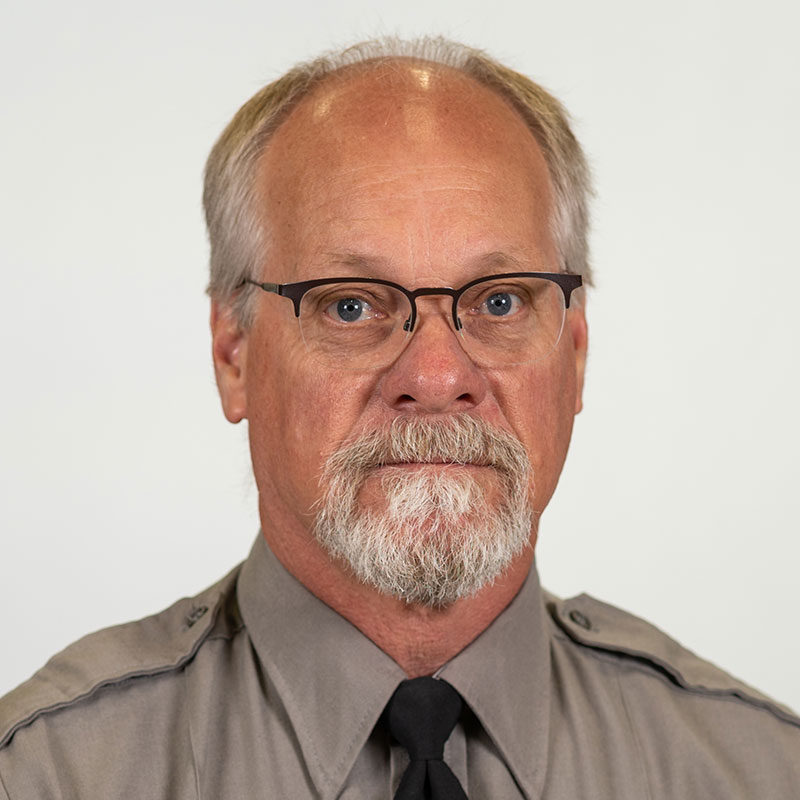Waterfowl hunters should do their part in preventing the spread of aquatic nuisance species into or within North Dakota.
Hunters must remove aquatic plants and plant fragments from decoys, strings and anchors; remove aquatic plant seeds and plant fragments from waders and other equipment before leaving hunting areas; remove all water from decoys, boats, motors, trailers and other watercraft; and remove all aquatic plants from boats and trailers before leaving a marsh or lake. In addition, hunters are encouraged to brush their hunting dogs free of mud and seeds.
Cattails and bulrushes may be transported as camouflage on boats. All other aquatic vegetation must be cleaned from boats prior to transportation into or within North Dakota.
Drain plugs on boats must remain pulled when a boat is in transit away from a water body.
In addition, hunters are reminded of a state law that requires motorized watercraft, including motorized duck boats, operated on state waters and not licensed in North Dakota, to display an ANS sticker, including an ANS fee of $15 to be paid each calendar year.
- ANS information, including regulations.
- Purchase the ANS sticker
The North Dakota Game and Fish Department allocated six bighorn sheep licenses for the 2023 hunting season, one more than last year.
A record 20,290 applicants applied for bighorn sheep. Prospective hunters were required to apply for a bighorn license earlier this year on the bighorn sheep, moose and elk application.
One license was issued in unit B1, one in B3, two in B4 and one in B5. In addition, one license, as authorized under North Dakota Century Code, was auctioned in May by the Midwest Chapter of the Wild Sheep Foundation, from which all proceeds are used to enhance bighorn sheep management in North Dakota.
Waterfowlers hunting from boats are encouraged to wear properly fitted life jackets while on the water.
Hunting coats with life jackets built in are light and comfortable to wear. In addition, wearing a life jacket will not only keep the overboard hunter afloat, but also slow the loss of critical body heat caused by exposure to cold water.
Capsizing and falling overboard from small boats are the most common types of fatal boating accidents for hunters.
Motorists should watch for deer along roadways this time of year as juvenile animals disperse from their home ranges.
October through early December is the peak period for deer-vehicle accidents. Motorists are advised to slow down and exercise caution after dark to reduce the likelihood of encounters with deer along roadways. Most deer-vehicle accidents occur primarily at dawn and dusk when deer are moving around.
Motorists should be aware of warning signs signaling deer are in the area. When you see one deer cross the road, look for a second or third deer to follow. Also, pay attention on roadways posted with Deer Crossing Area caution signs.
Deer-vehicle accidents are at times unavoidable. If an accident does happen, law enforcement authorities do not have to be notified if only the vehicle is damaged. However, if the accident involves personal injury or other property damage, then it must be reported.
In addition, a permit is required to take parts or the whole carcass of road-killed deer. Permits are free and available from Department game wardens and local law enforcement offices.
A few precautions can minimize chances of injury or property damage in a deer-vehicle crash.
- Always wear your seat belt.
- Don’t swerve or take the ditch to avoid hitting a deer. Try to brake as much as possible and stay on the roadway. Don’t lose control of your vehicle or slam into something else to miss the deer. You risk less injury by hitting the deer.
- If you spot deer ahead, slow down immediately and honk your horn.
The North Dakota Game and Fish Department is asking water recreationists and property owners to check for zebra mussels and other aquatic nuisance species when removing boat lifts, docks and other equipment from state waters.
Ben Holen, Department ANS coordinator, said water recreationists and property owners play a vital role in ANS prevention.
Zebra mussels attach to hard surfaces that are left in the water for long periods of time, first settling in tight spaces and areas that are protected from sunlight, Holen said. Equipment such as boat lifts and docks are high risk vectors for spreading ANS, especially zebra mussels.
“It makes it easier to do a thorough search when equipment is taken out of the water in fall,” he said. “Pay special attention to wheel wells, right angles on frames, and areas otherwise protected from sunlight. Feel for attached organisms that have small hair-like structures holding them in place. Small mussels can feel like rough sandpaper and adults can be as large as 2 inches long.”
Holen said if you think you’ve found a zebra mussel, take photos, write down any relevant information, such as how many were found and where, and report it online.
With North Dakota’s deer gun season opening in early November, many hunters will be looking for a place to sight in their firearms to get ready for the season.
The North Dakota Game and Fish Department manages five gun ranges on wildlife management areas in the state, and also partners with many local clubs around North Dakota to offer many other public shooting facilities.
The gun ranges managed by the Game and Fish Department include:
- Lewis and Clark WMA, located 6 miles southwest of Williston.
- Little Heart (Schmidt) Bottoms, located 12 miles south of Mandan off ND Highway 1806.
- MacLean Bottoms, located 2 miles south of ND Highway 1804, about 15 miles southeast of Bismarck.
- Riverdale WMA, located 2 miles southwest of Riverdale.
- Wilton Mine WMA, located 2 miles east of Wilton.
The Department may periodically close these ranges for routine maintenance and improvements. The status of each range can be found online. The website also provides a detailed listing of other shooting facilities in North Dakota.
 Mike Anderson, Game and Fish Department video production supervisor, with a paddlefish from the Missouri River.
Mike Anderson, Game and Fish Department video production supervisor, with a paddlefish from the Missouri River.
North Dakota Outdoors video news program reached a milestone of 1,500 programs in September. The two-minute show first aired in October of 1994. Mike Anderson, video project supervisor, has had his hand, behind the camera and in front of it, in roughly 1,450 of the programs. The program runs on about 14 different television stations around the state.
North Dakota Game and Fish Department enforcement personnel issues a reminder that a permit is required before taking possession of a dead deer found near a road or in a field.
Only shed antlers can be possessed without a permit.
Permits to possess are free and available from game wardens and local law enforcement offices.
In addition, hunters are reminded to properly dispose of dead deer. A deer carcass transported outside of it’s respective gun unit must be disposed of via landfill or waste management provider.
The North Dakota Game and Fish Department is taking orders for its North Dakota OUTDOORS calendar, the source for all hunting season and application dates for 2024. Along with color photographs of North Dakota’s wildlife and outstanding scenery, it also includes sunrise-sunset times and moon phases.
Calendars must be ordered online.
The calendar is the North Dakota OUTDOORS magazine’s December issue, so current subscribers will automatically receive it in the mail.
Whooping cranes are in the midst of their fall migration and sightings will increase as they make their way into and through North Dakota over the next several weeks. Anyone seeing these endangered birds as they move through the state is asked to report sightings so the birds can be tracked.
The whooping cranes that do make their way through North Dakota each fall are part of a population of about 500 birds that are on their way from nesting grounds at Wood Buffalo National Park in Canada to wintering grounds at Aransas National Wildlife Refuge in Texas, a distance of about 2,500 miles.
Whoopers stand about five feet tall and have a wingspan of about seven feet from tip to tip. They are bright white with black wing tips, which are visible only when the wings are outspread. In flight they extend their long necks forward, while their long, slender legs extend behind the tail. Whooping cranes typically migrate singly, or in groups of 2-3 birds, and may be associated with sandhill cranes.
Other white birds such as snow geese, swans and egrets are often mistaken for whooping cranes. The most common misidentification is pelicans, because their wingspan is similar, and they tuck their pouch in flight, leaving a silhouette like a crane when viewed from below.
Anyone sighting whoopers should not disturb them, but record the date, time, location and the birds’ activity. Observers should also look closely for and report colored bands which may occur on one or both legs. Whooping cranes have been marked with colored leg bands to help determine their identity.
Whooping crane sightings should be reported to the U.S. Fish and Wildlife Service offices at Lostwood, 701-848-2466; Audubon, 701-442-5474; the North Dakota Game and Fish Department, 701-328-6300; or to local game wardens across the state. Reports help biologists locate important whooping crane habitat areas, monitor marked birds, determine survival and population numbers, and identify times and migration routes.
The storied past of waterfowl in North Dakota is uniquely revealed in the North Dakota Game and Fish Department’s publication, “The Duck Factory – A History of Waterfowl in North Dakota.”
Certainly of interest to waterfowlers and other outdoor enthusiasts, the 213-page, full color, soft-cover publication is authored by Mike Jacobs and Erik Fritzell. The book traces the history of waterfowl species and their habitats in North Dakota.
“The Duck Factory” is an important story because of North Dakota’s longtime and continuing contribution to the world of migratory birds, said Mike Szymanski, Department migratory game bird management supervisor.
“North Dakota is the most important state for breeding ducks,” he added. “The contribution of ducks from North Dakota into the fall flight is unmatched by any other state, and its importance to duck hunters cannot be understated. Describing the history of waterfowl in North Dakota was a story that we felt was certainly worth telling.”
The book is sold only online for $24.99, including shipping.
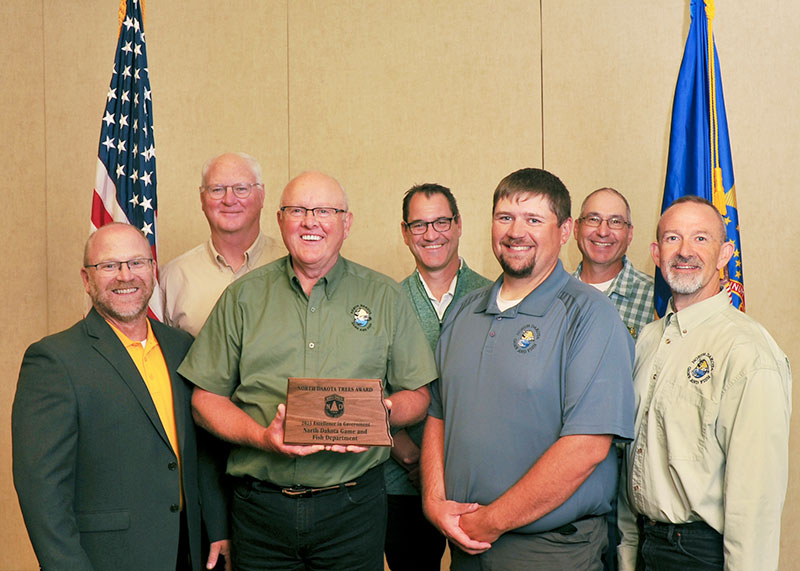 Pictured from left: Tom Claeys, North Dakota Forest Service state forester; Kent Luttschwager, Game and Fish Department wildlife resource management section leader; Scott Peterson, Game and Fish Department deputy director; Dr. David Cook, NDSU president; Jonathan Tofteland, Game and Fish Department district warden; Scott Olson, Game and Fish Department wildlife biological technician; and Brian Prince, Game and Fish Department wildlife resource management supervisor.
Pictured from left: Tom Claeys, North Dakota Forest Service state forester; Kent Luttschwager, Game and Fish Department wildlife resource management section leader; Scott Peterson, Game and Fish Department deputy director; Dr. David Cook, NDSU president; Jonathan Tofteland, Game and Fish Department district warden; Scott Olson, Game and Fish Department wildlife biological technician; and Brian Prince, Game and Fish Department wildlife resource management supervisor.
Trees Award Winners
The North Dakota Game and Fish Department and agency wildlife resource management supervisor, Brian Prince, were celebrated at the Trees Awards in Fargo in early September.
The Department received the 2023 Excellence in Government Trees Award, which is presented to an agency or division of government at any level that exhibits extraordinary effort and dedication in the conduct of programs and projects that result in a significant benefit to forestry.
“North Dakota Game and Fish Department has done just this, implementing forest improvement practices across the state for the benefit of wildlife,” wrote Tom Claeys, North Dakota Forest Service state forester.
Prince, of Devils Lake, was honored as the 2023 Natural Resource Professional of the Year for his innovation and promotion of sustainable forest management in his region.
The Trees Awards recognize those who contribute in outstanding ways to forestry activities including fire mitigation, tree planting or environmental education. The Trees Awards are sponsored by the NDSU-North Dakota Forest Service and presented during the Trees Bowl at North Dakota State University.
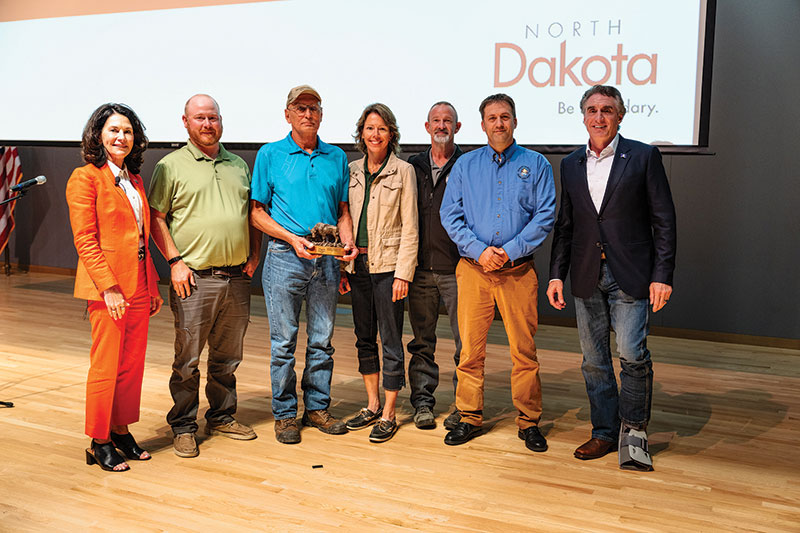 Picture from left: Lt. Governor Tammy Miller; Cody Clemenson, North Dakota Forest Service forest steward specialist; Ron Davis, Turtle Mountain Band of Chippewa; Jodi Delozier NDSU Extension Service extension specialist; Brian Prince, Game and Fish Department wildlife resource management supervisor; Kevin Kading, Game and Fish Department private land section leader; and Governor Doug Burgum.
Picture from left: Lt. Governor Tammy Miller; Cody Clemenson, North Dakota Forest Service forest steward specialist; Ron Davis, Turtle Mountain Band of Chippewa; Jodi Delozier NDSU Extension Service extension specialist; Brian Prince, Game and Fish Department wildlife resource management supervisor; Kevin Kading, Game and Fish Department private land section leader; and Governor Doug Burgum.
Roaming Bison Award
The Turtle Mountain Forest Management team was awarded the Roaming Bison Award in September at the 2023 Governor’s Awards for Excellence in Public Service, which recognized team members across state government for their commitment in providing the highest levels of service to North Dakota.
The team, made up of the North Dakota Game and Fish Department, North Dakota Forest Service NDSU Extension and Turtle Mountain Band of Chippewa, was recognized for their work to ensure that the unique and cherished forest area is managed sustainably for current and future generations.
Agency Garners National Recognition
 Brian Hosek (left), Shane Wegner (right)
Brian Hosek (left), Shane Wegner (right)
The Center for Digital Government announced the North Dakota Game and Fish Department and North Dakota Information Technology as winners of the 2023 Government Experience Awards.
Launched in 2021, the electronic posting project, spearheaded by Brian Hosek, Game and Fish Department business operations manager, is a tool for both landowners and hunters to identify posted lands digitally within the state. This results in reduced cost and effort to post land physically, while ensuring it meets legal posting requirements.
“State parcels have always been a top data priority for the state. There are numerous use cases for this information that benefit many citizens of North Dakota. The state’s electronic posting system is one example,” Hosek said. “The collaboration and talent of this team, including Melvin Faris, NDIT and Shane Wegner, Game and Fish Department, has resulted in a successful outcome for electronic posting and the state parcel project.”
Longtime Bowman Warden Retires
North Dakota Game and Fish Department game warden, Art Cox, retired after 25 years with the agency.
“Art was an extremely valuable member of the Department and enforcement division,” said Scott Winkelman, enforcement division chief. “Having spent his entire career stationed in Bowman, he had excellent insight and knowledge of the southwestern corner of the state, its residents, and all those who enjoyed hunting, fishing, trapping and boating there. Art’s experience and knowledge will be missed.”
Dinges Moves to PLI
Andy Dinges was named the Game and Fish Department’s west region private land initiative supervisor.
Prior to accepting the position, Dinges was a migratory game bird biologist for the Department for eight years.
Pike Joins Lonetree Staff
Trevor Pike has been named wildlife biological technician for the Game and Fish Department at Lonetree Wildlife Management Area near Harvey.
Pike graduated from the University of Wisconsin-Stevens Point with a degree in wildlife ecology and management.
Rott Named to Fisheries Staff
Lucas Rott has been named fisheries biological technician for the Game and Fish Department in southeastern North Dakota.
Rott worked for several years as a long-term seasonal employee in Riverdale before securing his new position in Jamestown.


